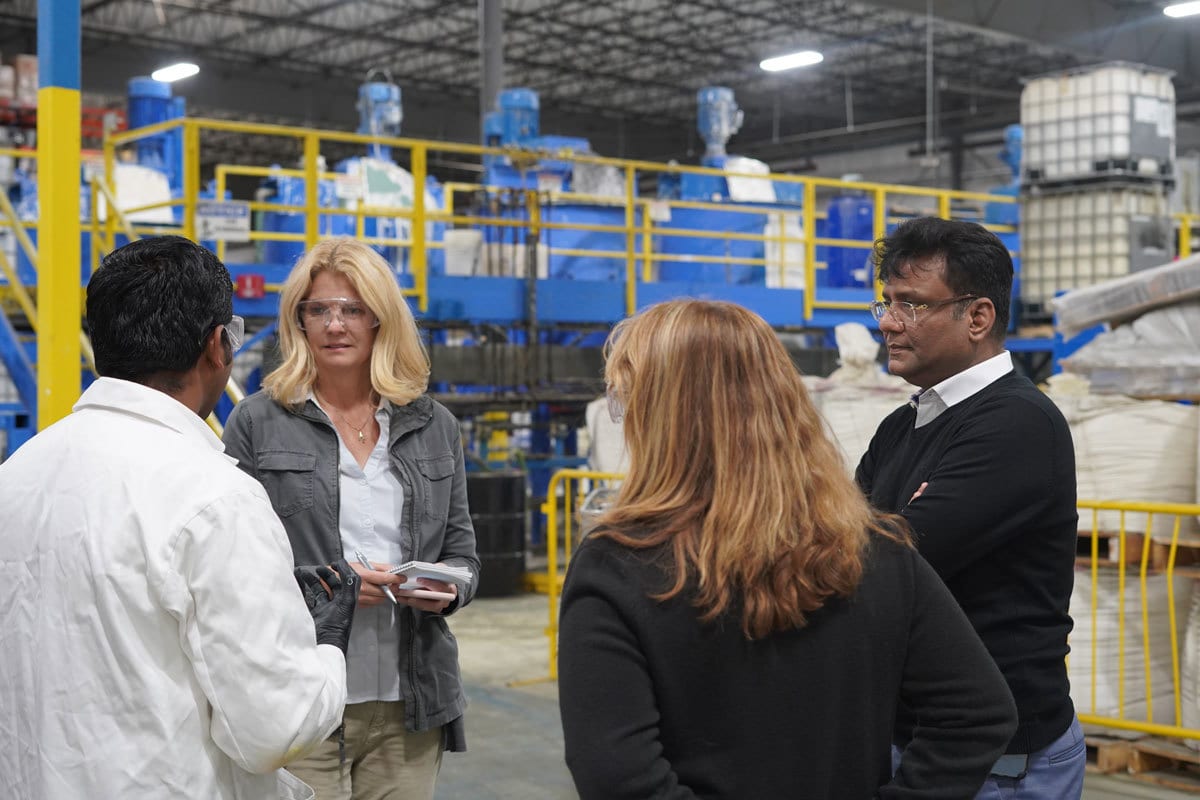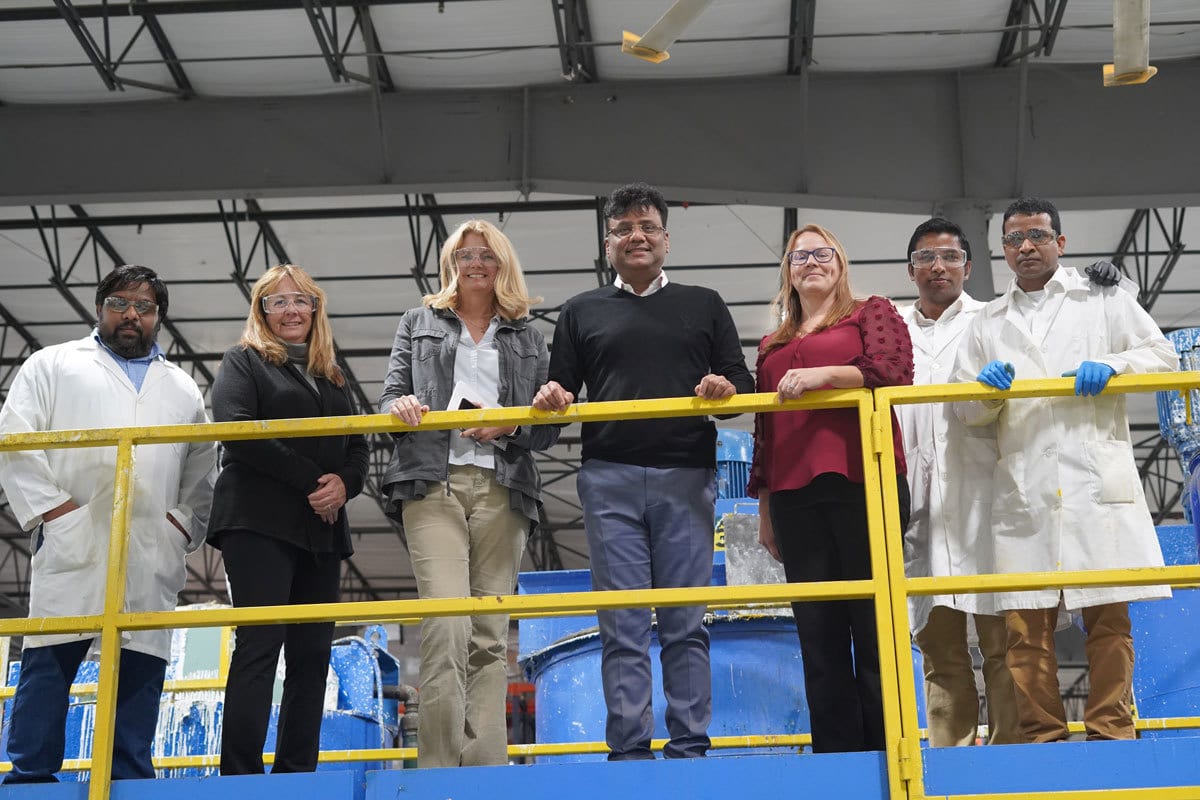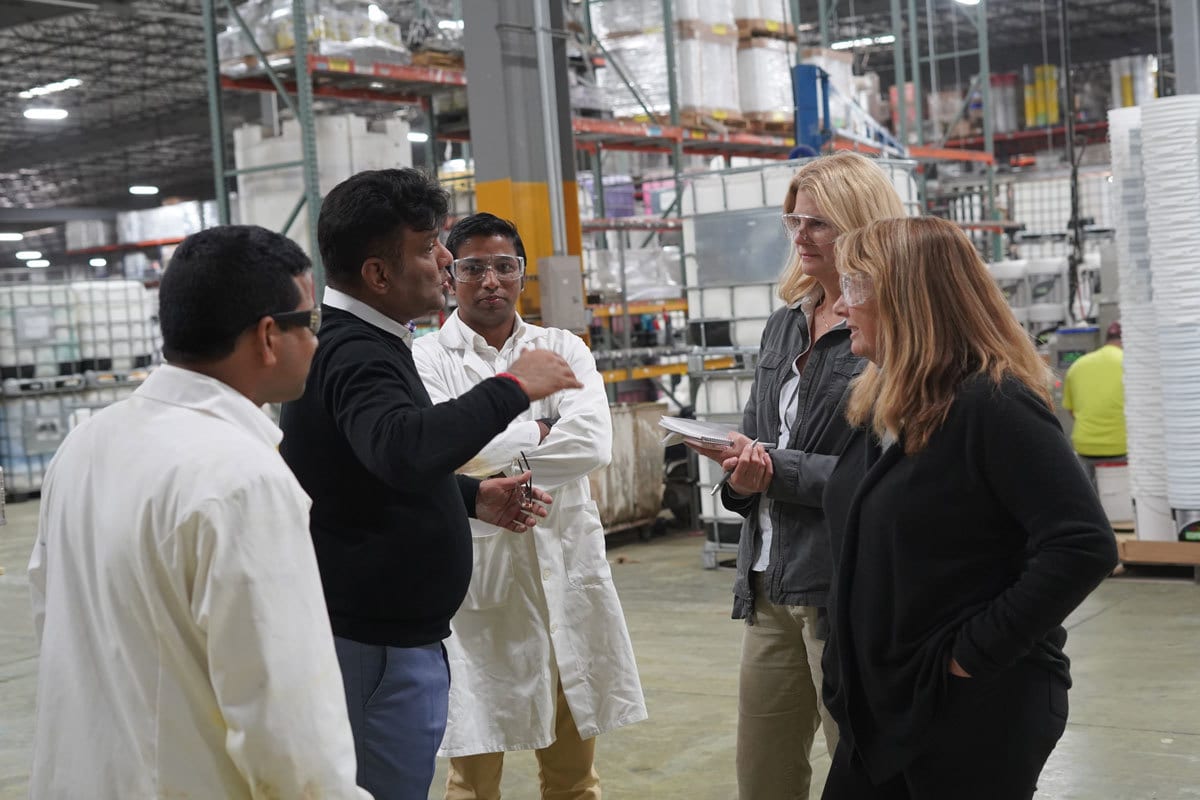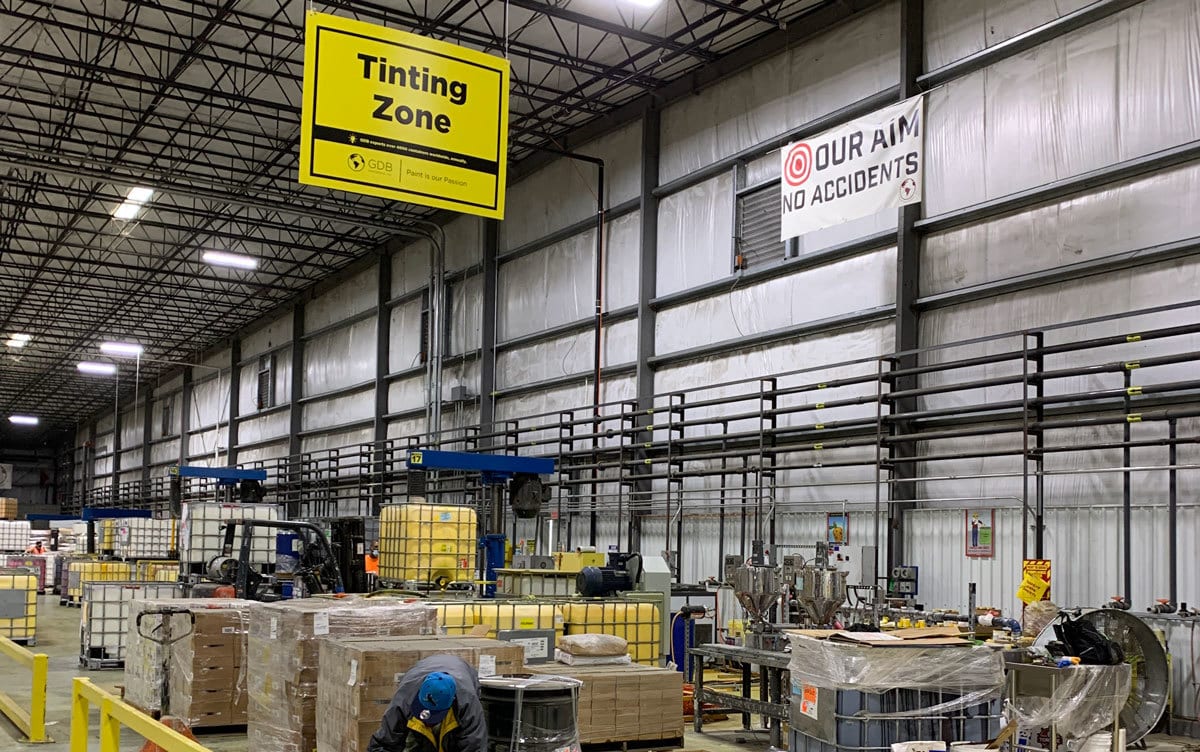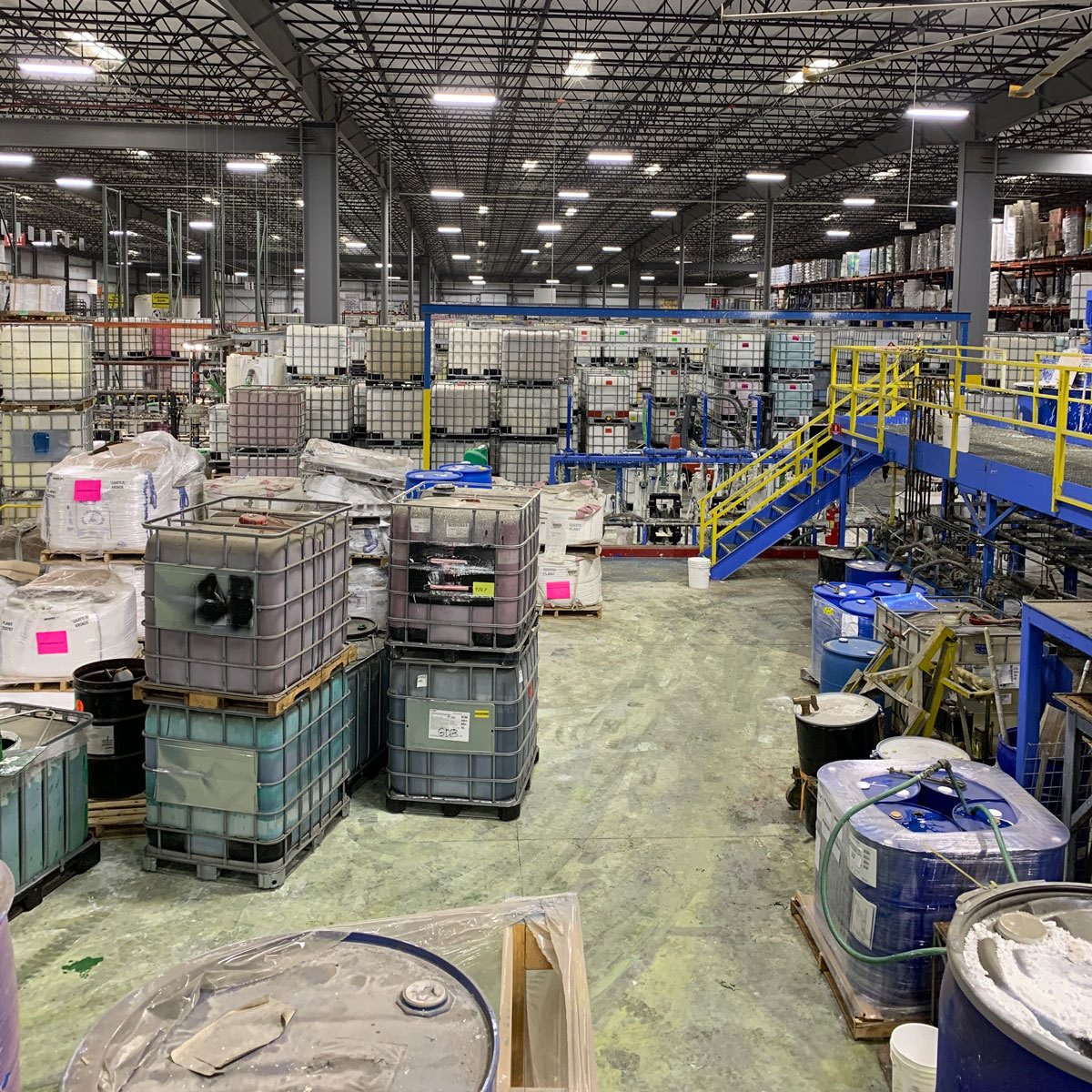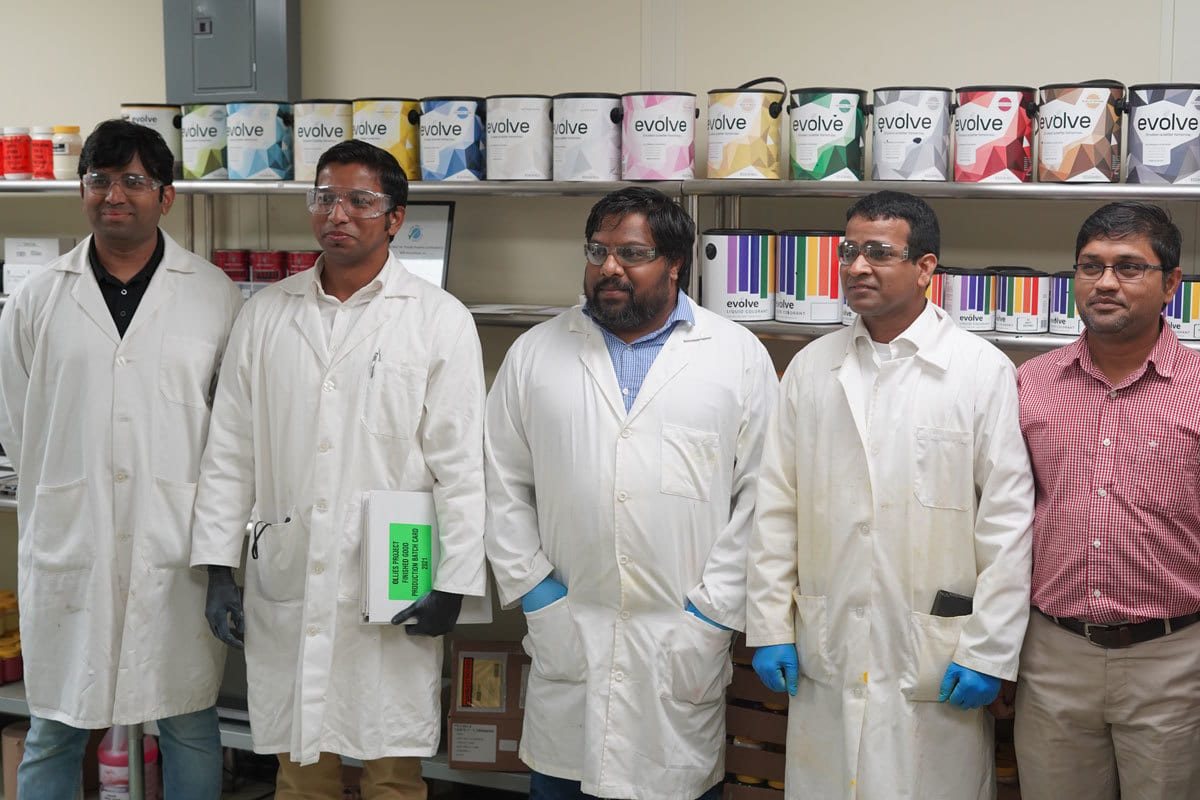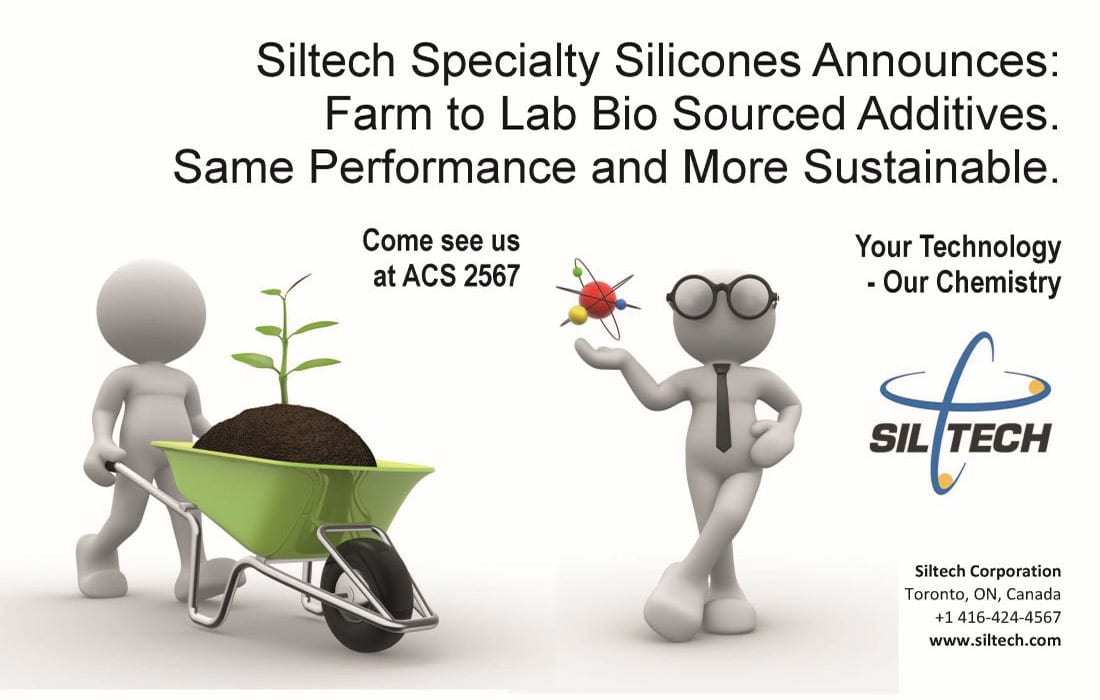Ready to proof -- CLJ 02/03/2022
Revised 2/3
Ready for author
Photo: davincidig, iStock/Getty Images Plus, via Getty Images
Painting a Brighter Future Through Paint Recycling
PCI recently visited GDB International to learn about the company, its mission, and its paint recycling and manufacturing process.
By Kristin Johansson, Editor-in-Chief, Paint & Coatings Industry Magazine, Troy, MI
In late 2021, GDB International Inc. invited PCI Magazine to visit its paint recycling headquarters in Nashville, IL. Over the course of two days, Sales Manager Lisa Guldan and I met with company CEO Sanjeev Bagaria and many more company employees to learn about GDB’s history, mission and plans for the future.
A paint recycling company, GDB International celebrates its 25th anniversary in 2022. The company strives for innovative and environment-friendly solutions to meet the recycling demands of the paint industry by producing premium recycled paint at competitive prices for consumer markets.
Based in New Jersey, GDB’s passion for paint has helped them establish the world’s largest paint recycling and processing facility at its Nashville, IL, location. The company also has a research and development lab in Nashville, with supporting satellite locations in Nevada, Texas, Seattle, New York and California. The company also has warehouses and distribution centers in China, Mexico, Australia, UAE Ghana, India and the Netherlands. Overall, the company has 1.9 million square feet of recycling and warehouse space, manages 6,000 inbound and outbound truckloads every year, collects over 10 million gallons of paint annually and has over 450 employees.
The Importance of Recycling
The first stop on our visit was an educational meeting, where Sanjeev explained the importance of paint recycling. He noted that 80+ million gallons of leftover paint goes to landfill every year. Landfilled paint and its VOCs, fungicides and toxic metals leach out into the ground, contaminating the land, the ground water and the air we breathe. According to GDB, one gallon of paint in landfills can ruin an entire year’s supply of drinking water for almost 50 people. The benefits of recycling paint are numerous, including the following:
- One gallon of recycled paint saves 100 Kilowatt-hours of energy and keeps 120 pounds of CO2 out of the air.
- One gallon of recycled paint saves half a gallon of fresh water.
- Other than benefitting our communities and the environment, recycling paint reduces the need for virgin raw materials and saves energy required for their extraction and manufacture.
Credit: Fevziie Ryman, Creatas Video+/Getty Images Plus, via Getty Images
PaintCare
Paint recycling got its big boost back in 2007, when the Product Stewardship Institute spearheaded a multi-stakeholder agreement with the American Coatings Association (ACA), which resulted in the beginning of U.S. state laws requiring paint producers to take responsibility for safely managing leftover paint. In response, ACA established PaintCare Inc., a nonprofit organization that manages leftover paint on behalf of the paint manufacturing industry. There are now 10 state paint producer responsibility laws, the newest of which will launch May 1 in New York. Washington, D.C. also participates in the program.
Under the stewardship program, all companies manufacturing or shipping paint to these states pay an up-front per-gallon fee. Fees vary by container size up to 5-gallons and are different in each state. PaintCare uses these funds to operate the paint stewardship programs including collection, transportation and processing of paint, as well as public outreach in each state. It establishes sites throughout the state for consumers to easily drop off unused/leftover paint. PaintCare covers costs for supplies, promotion and signage, and training of staff at sites. These include paint retailers, hardware stores, lumber yards, material reuse stores and government-run solid waste programs.
Once a reusable paint collection box is full, the company notifies PaintCare, and a pick-up is scheduled. In the state of California alone there are over 800 collection sites.
To date, PaintCare has collected over 55 million gallons of leftover architectural paint from customers at designated sites in states with paint recycling laws. In 2021 alone, it is estimated that more than 8 million gallons were collected. PaintCare then sends much of the collected paint to recycled paint manufacturers like GDB International, where it is sorted, processed and remanufactured. Some
of the collected paint may also be made available for immediate reuse, used as a fuel, or put to another beneficial use.
The GDB Business Model
GDB collects leftover/unused paint and raw materials from a variety of sources, and then remanufactures it into its own brand of high-quality paint.
Post Consumer
One segment of GDB’s business is collecting unused/leftover post-consumer paint through the PaintCare program. The company manages about 900 semi truckloads across the world, as similar programs have been developed in Europe and Australia as well.
GDB’s 500,000-square-foot in-bound receiving warehouse that stores unused/leftover paint and raw materials.

Paint Manufacturers
GDB works with all paint manufacturers to collect any unused, off-spec, discontinued or over-stocked paint. GDB does not charge manufacturers to take their paint. In fact in order to be able to recycle the paint and not destroy it, the EPA requires GDB to pay manufacturers for it. They pay for the freight as well.
Retail Outlets
GDB also works with all paint retail outlets like Home Depot, Lowes, Walmart, ACE, True Value, etc. to collect any of their leftover, mis-tinted, returned or discontinued paint.
Raw Material Manufacturers
GDB also collects unused, overstocked or off-spec raw materials, and wash water and wash solvent that would otherwise be destroyed, and re-works them into their paint.
Other Products
The company also recycles leftover or unused spray cans, and repackages and sells unused, returned and leftover brushes, rollers, applicators, etc
Remanufacturing/Recycling
After collecting all of the unused raw materials and paint, GDB’s team of chemists remanufactures these products into its own Evolve and Diamond brands of high-quality paint in batches for specific projects for organizations like Habitat for Humanity, or for cities and counties, and also manufactures large quantities of pre-packaged colors for sale. The company sells its paint to discount retailers in the U.S. and overseas, as well as through its 11 outlet stores. To date, GDB has successfully recycled more than 11 million gallons of paint (almost 1.8 billion pounds of products).
Sanjeev Bagaria showcases GDB’s Evolve line of colored recycled paint.
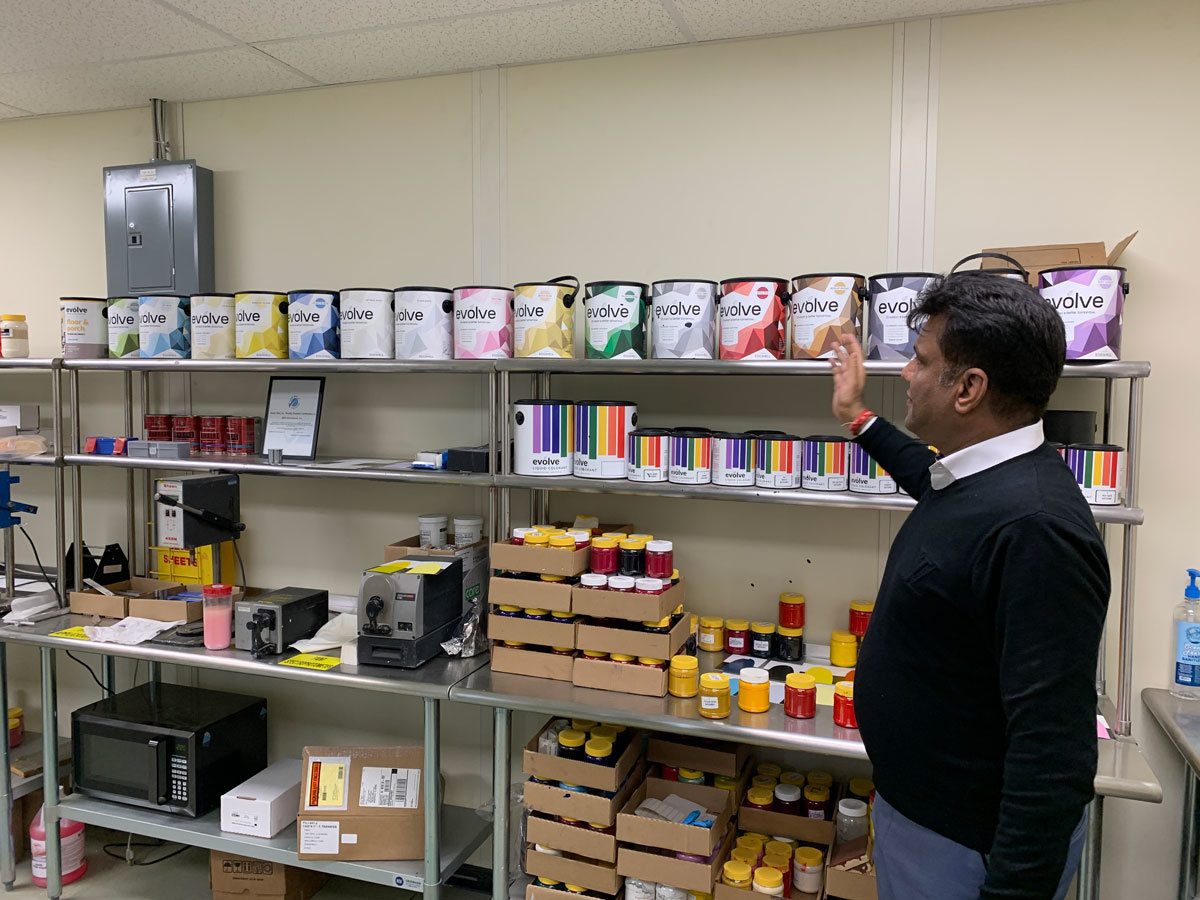
A Zero-Waste Facility
Not only does GDB help the planet by recycling paint, it has a zero-waste policy for its entire facility. Buckets that cannot be reused are dried and shredded in an in-house shredder, and then baled for recycling. All metal cans are baled in the company’s custom-built bailing machine before recycling. All boxes, cartons and bulk bags are recycled. All paint drums and totes that cannot be unmarked or reused are recycled. All original labels are cut off from the cans, collected and recycled – this also ensures 100% brand protection.
Touring the Plant
After learning about GDB’s business model, we were treated to a tour of the facility. We started in the 500,000-square-foot in-bound receiving warehouse, where all products coming from industry are stored. The company has a robust inventory system, where every product that comes in gets its own tag number. From here, products go to the recycling building. Products coming from the retail industry are received and warehoused in their own 250,000-square-foot building.
Touring the in-bound receiving warehouse.
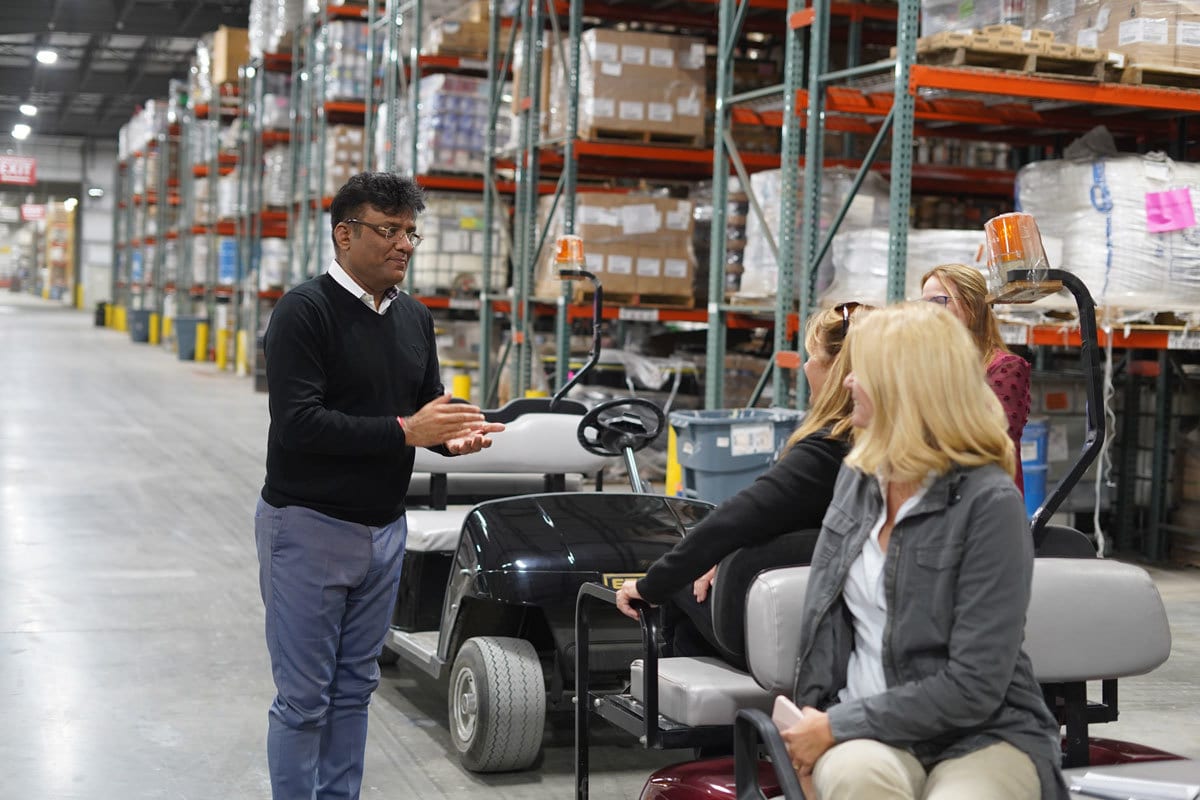
Paint Remanufacturing
In the recycling building, all brands of white paint are sorted by sheen, poured into tanks, mixed and filtered. Raw materials are added to improve the formulas, and TiO2 is added to make it pure white. The paint is then tested by chemists to make sure it meets GDB’s quality standards. Paint cans are filled with newly minted recycled paint by an automatic paint-filling machine, and each can is labeled by machine as well. All the paper labels are made from recycled paper. After this stage, the paint is ready to be shipped to organizations, projects and retail outlets.
Recycled white paint.
A shipment of white paint is ready to send to Habitat for Humanity.
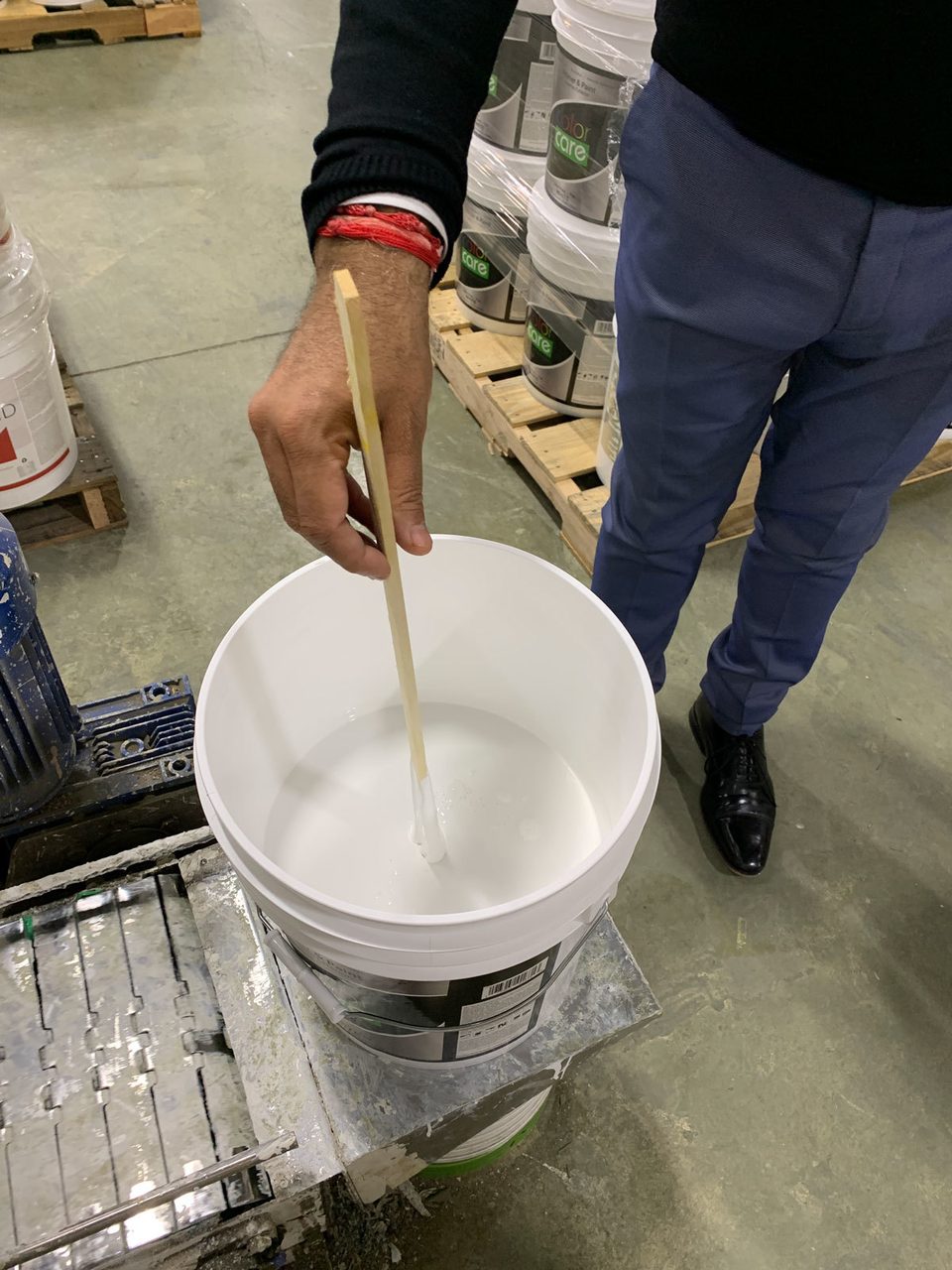
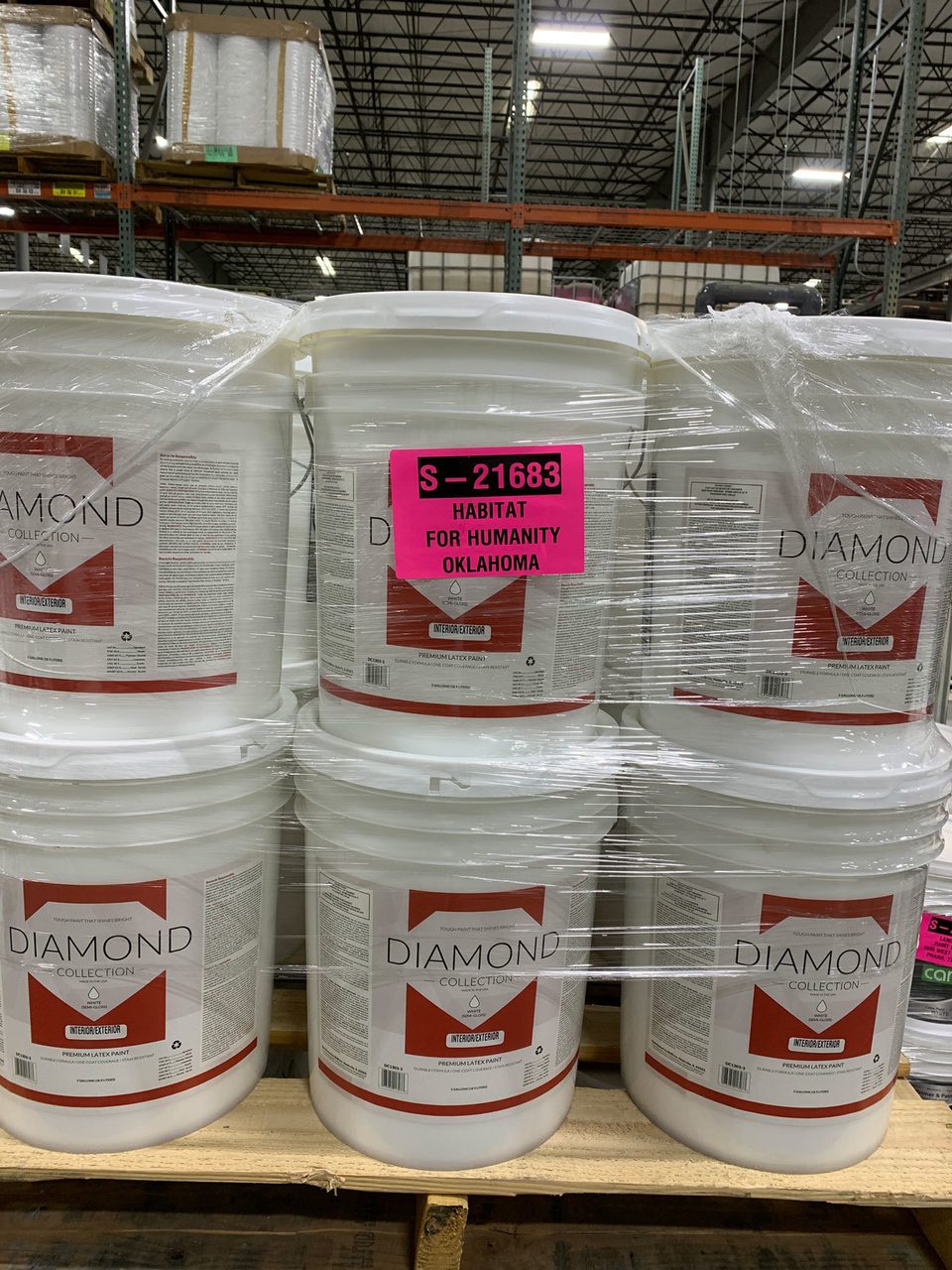
Tinted post-consumer paints go through a more extensive process. First they are sorted and poured into different totes on the basis of color, sheen and type (water-based/solvent-based). Paint is sorted based on prime colors such as white, black, yellow, red and others.
Sorted paint is dumped in the respective color station. The dumping station is equipped with layers of metal mesh, which removes bigger chunks from the paint. Every light and dark shade of color gets dropped in a primary color (e.g., wine red and cherry red get grouped into a tote that contains shades of red). After dumping, the metal, plastic and hybrid cans are sorted, then dried, and subsequently sent to the baler. All these empty cans get recycled.
The collected paint, now segregated by color and type and poured into totes, is ready to be mixed to obtain a homogenous product. After mixing, the totes undergo the same quality control testing as the white paints. The QC results determine whether any additions will be made to enhance the quality of the recycled paint. Additives, which are used under the supervision of a paint chemist, include rheology modifiers, binders and pH stabilizers, and are applied in GDB’s 10,000-gallon tanks or totes directly. Finished totes get coded by sheen level and color.
Finished totes are coded by sheen level and color.
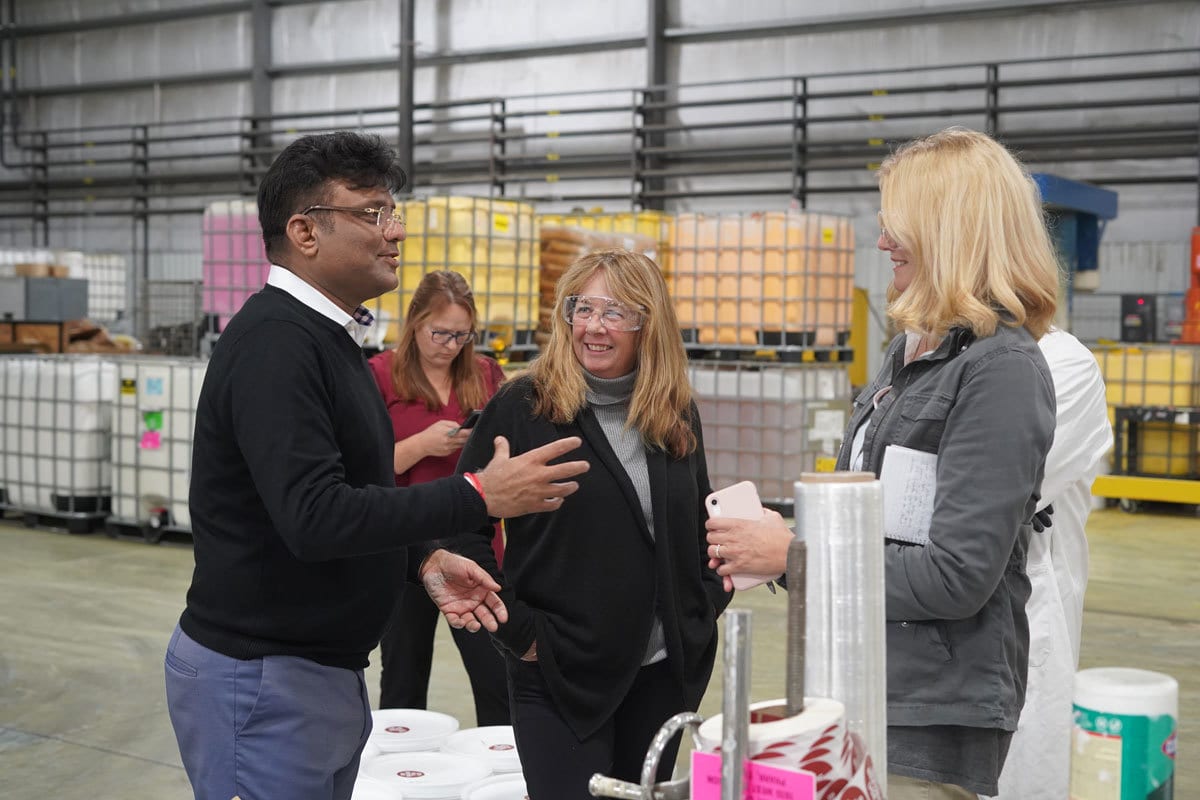
Filtration is an important but complicated process in paint recycling, and decides the quality of the product and waste generation. The paint is passed through 300 micron filtration to ensure no particulate matter remains within the finished product. The product is then passed through the company’s patent-pending, custom-built Vibroshaker to further ensure no particulate matter remains.
GDB’s patent-pending Vibroshaker.
GDB manufactures 16 colors of paint. Shades of color from recycled paint get mixed in different ratios to achieve the desired shade from these standard shade cards. GDB has experts on staff to do the shade matching since it is such an important component of the process. The required color difference should be less than 0.5ΔE when compared to master shades of Evolve colors.
GDB chemists match the recycled paint colors.


At this stage, the recycled paint has similar properties and performance as virgin paint and is filled in labelled cans.
The remanufactured paint is filled into new labelled cans.
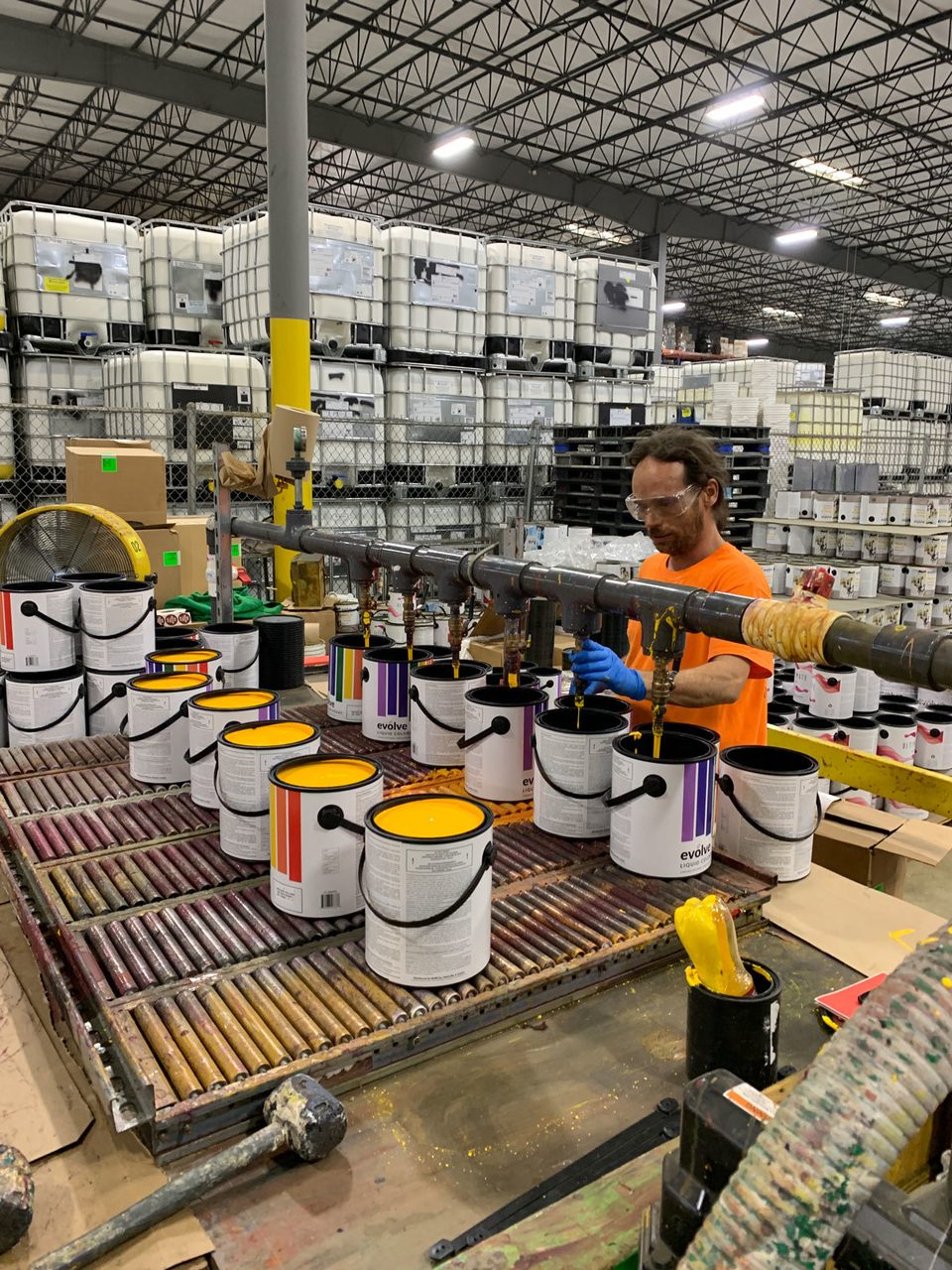
Future Plans
GDB recently acquired a paint manufacturing plant in the region. The plant is fully automated and equipped to manufacture both water-based and solvent-based paint. The plant's large production capacity of five million gallons per year adds to the company's existing production capacity of two million gallons, allowing GDB to further expand its markets. Bagaria also stated that by 2023 the company plans to have 30 Evolve retail stores in operation.
GDB’s newly acquired paint manufacturing plant.


But in addition to growing his company, Bagaria hopes to help raise awareness of and expand the PaintCare program to all states. Additionally, he hopes to change the reputation of recycled paint. The term “recycled” is positive in terms of the benefits it provides to our environment, but often implies a lower-quality product. Bagaria notes that, if done right, recycled paint can be high-quality and have the same properties as virgin paint. He hopes to change “recycled” to “environmentally friendly”.
Sanjeev Bagaria and the entire GDB International team gave us the royal treatment during our two-day visit. And it was truly an eye-opening learning experience. GDB has created a masterful reuse of various waste products in the coatings industry, which otherwise would have led to several million pounds of materials in landfills and fuel blending. I look forward to watching your business continue to evolve, and for the PaintCare program to expand throughout the entire country. And most importantly, for paint recycling to become more widely accepted and appreciated around the world.
I would like to thank Sanjeev Bagaria and Ganesh Kulkarni, Technical Director of GDB International Inc., as well as the Product Stewardship Institute and PaintCare Inc., for providing articles and information used in this article. Information was also obtained through the GDB website.
Click the slideshow arrows below to see more photos of PCI’s tour!
